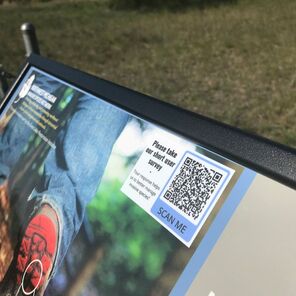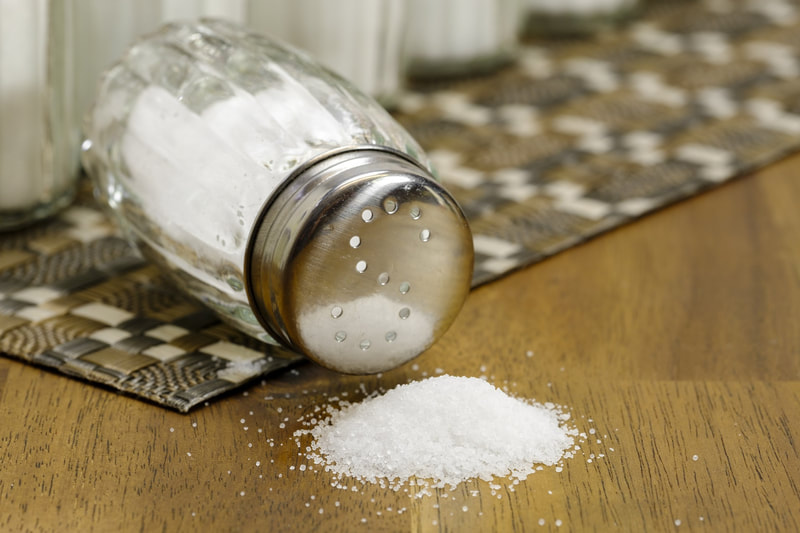ISN Hosting Summer-long Giveaway - Use boot brush stations and enter for a chance to win ISN swag!6/2/2021
Funding provided in part by the Michigan Invasive Species Grant Program.
0 Comments
Author: Katie Grzesiak, ISN Coordinator At ISN we get a lot of questions about “homemade” alternatives to traditional herbicides, including Epsom salts, table salt, vinegar, and hammering copper nails into trees. This article is a more in-depth exploration of these methods, including references. First, it’s important to define an herbicide as an agent applied to a plant to kill, defoliate, or otherwise impede its growth. An herbicide can be a glyphosate product or other “traditional” herbicide, or an organic herbicide like copper sulfate; home remedies also become herbicides when they’re applied to plants! It’s also important to note that anything being used as an herbicide has a potential to be hazardous to humans in some way, whether it’s a short-term hazard (like a physical or chemical burn on the skin) or more long-term. Caution is important, including wearing appropriate personal protective equipment (PPE) and storing safely. However, using agents that are not tested and labeled as herbicides means you don’t know what precautions are necessary for yourself or the environment. Questions about pesticide testing and registration should be directed to the Michigan Department of Agriculture and Rural Development. Second, herbicides are just one tool in the invasive species management toolbox (also called Integrated Pest Management). Many invasive species can be controlled by physical, cultural, and/or mechanical means, and others have biological enemies to help keep them in check. If you’d like assistance in choosing the method that’s right for you, please contact us! We’d be happy to help you choose between the available options, which vary by species, site, budget, and time available.  Photo courtesy of Heatweed Technologies Photo courtesy of Heatweed Technologies Epsom salts (MgSO4) have historically been used as fertilizer; in theory, you could apply them at such high concentrations that they kill plants, but it would take a lot, and could damage soils long-term. ISN does not recommend using Epsom salts as an herbicide. Copper nails driven into an undesirable tree’s trunk are an often-told home remedy. However, while copper can absolutely be toxic (it’s a main ingredient in several herbicides, particularly those used in organic settings), you’d need to use a LOT of nails to get enough copper into the tree’s system to cause harm, at which point you’d be close to girdling the tree (which would kill many non-suckering trees anyway). Additionally, copper nails are expensive! If you’re thinking about copper nails and want to avoid herbicides, you may want to consider girdling or just cutting down the tree or shrub instead. ISN does not recommend using copper nails as an herbicide. Table salt (NaCl) will definitely kill plants—salt is very toxic! However, it will also kill the next thing you plant in that spot… and possibly the one after that, and after that. It can permanently damage the soil; there’s an old tradition about “salting the earth” (not to be confused with “salt of the earth”) after defeating an enemy, and it’s quite a potent curse! If you were considering using table salt on a cut stem or stump, you may want to consider traditional herbicide or horticultural vinegar instead, as there are options that don’t remain active in soil for very long. ISN does not recommend using table salt—or any other salt, like rock salt—as an herbicide. Boiling water has been used very successfully to kill plants in a variety of settings, as the heat ruptures cells and kills the tissues. Just pouring it out of the kettle onto the offending weed can work well, provided the weed is small enough to be affected (a great way to take care of weeds in sidewalk cracks, for example). However, for hardier weeds with deep roots or even just larger plants, this may not be enough. Several companies have created ways to inject heated water into roots, spray it out over an area, or otherwise target undesirable species. (See photo for an example of Heatweed Technologies using this method). This can be very effective, though, safety for the applicator as well as any nearby plants must be considered. Of course, as soon as the water cools down a bit, it’s just regular water and harmless (but also ineffective for plant control). ISN recommends using boiling water in situations where contact-kill is acceptable, or where proper machinery is used to deliver the desired result. Vinegar (acetic acid) will also kill plants; it does a great job of destroying the proteins that make up cells. It can also lower the pH of soil (make it more acidic), which can be inhospitable to growing things, though vinegar will break down in soil over time. It acts as a “contact herbicide,” meaning it kills or damages any part of the plant it comes into contact with (or the plant next to it!), but is not transported to other parts of the plant; if the plant is big enough it could be damaged in one area, but perfectly healthy in another. Kitchen vinegars, like white and cider, are just 5% acetic acid (that’s not strong enough completely kill more than a seedling dandelion), and are not labeled for use as herbicides; ISN does not recommend using kitchen vinegars as herbicides. There are horticultural vinegars that are much more potent—usually about 20% acetic acid—that are labeled to be sold as herbicides and can be very effective. At that concentration, however, horticultural vinegar can also harm humans and other animals, and care should be taken (including reading and following the label—it’s the law!) to use it property. It’s also important to note that horticultural vinegar is actually more acutely toxic to animals than some traditional herbicides, which often comes as a surprise! Good uses for horticultural vinegar include preventing stump-sprouting on a recently cut tree (though not those that root sucker), or foliar-spraying a weed or small shrub that does not have a deep root structure. ISN does not recommend using horticultural vinegar outside of its labeled use, or in situations where a systemic herbicide is required for successful control. ISN recommends using horticultural vinegar according to its label in situations where a contact herbicide is desired. Soaps, including dish soap and Castile soap, are not an herbicide, but are often recommended for use as an at-home surfactant (an herbicide additive that helps the active ingredient stick to a slippery plant surface). However, soap comes with risk—it harms fish and frogs when it gets into waterways by making it difficult for them to breathe, even destroying their skin/gills. Even very small amounts of soap can harm them! Approved, fish-safe surfactants are not expensive and can be purchased from a local herbicide purveyor for use in plant control projects. ISN does not recommend using soap for activities beyond washing (or fun bubble-making), and only far from natural water sources. Combinations of various ingredients (Epsom salt + vinegar + soap is especially popular online) are generally not recommended, as there is no evidence that the combination works better than just the most effective ingredient alone. We know this is a lot of information, and a lot of variables. If you’d like assistance in choosing the method that’s right for you, please contact us! We’d be happy to help you choose between the available options, which vary by species, site, budget, landowner preferences, and time available. References and further reading:
Author: Emily Cook, ISN Outreach Specialist Two expanses of forest, just east of Frankfort in Benzie County, are gradually being restored with the goal of natural communities being returned to their original state. These parcels, acquired by Frankfort/Elberta Public Schools, have seen much change - from original cutover, ongoing farming, and then abandonment. This naturally led to the establishment of a healthy population of woody invasive shrubs like honeysuckle, barberry, and autumn olive. These species are opportunistic in settings such as this (and quickly take over).
Ultimately, another goal is to restore the area for educational use. Kama Ross, ISN Partner and FAP Forester for Benzie, Grand Traverse, and Leelanau Counties refers to the Forest Stewardship website to explain. "The concept of school forests in Michigan dates back to 1925 with the Negaunee Schools in the Upper Peninsula. The program grew statewide in 1931 when the Municipal Forest Act was passed by the Michigan Legislature, allowing the Department of Conservation (i.e. the Michigan DNR) to take tax reverted properties (those with delinquent property tax payments) and transfer ownership to schools and government organizations. The forests are not just for schools; they are open to public access, providing both educational opportunities and community-wide benefit." In the meantime, there's a lot of work to do. First, determining the best management practices and subsequent restoration requires diving into published information, historical forest records, and looking at neighboring parcels. Liana May, Owner of Borealis Consulting, has been working diligently to determine the design and process which she says is, "one of the most challenging parts of the process". "Though we rely on the best published information, every forested area is different; soils, microclimate, ecological interactions, all vary from site to site; so we have designed what we think will be a successful start to a diverse and climate resilient hardwood stand that provides well for wildlife" Seeing that design come to life is already well underway. In January of this year, Wildlife and Wetlands Solutions, LLC began the process of removing the woody invasives on site - an impressive endeavor. Now, much of the standing red pine is being logged. Other beneficial trees will be left standing including white pine, black cherry, sugar maple, white spruce, and American beech. Come spring, new seedlings will be planted, some with an emphasis on replacing beech and ash trees affected by insect and disease. Kama admits she is a bit worried about seedling success with no water source on the property but only time will tell which trees do the best on these sites. Let's all keep our fingers crossed for some spring and summer rain! Eventually, students from the nearby schools will be able to see the forest regeneration first-hand and maybe even assist with some invasive species removal. Garlic mustard is present and will likely worsen at first due to the shrub removal and subsequent logging. Members of the public may also have the opportunity to assist with bare root seedling planting although those plans are still in development. If you would like to learn more about this project and/or be kept in the loop regarding volunteer opportunities, please contact Kama directly - [email protected]. |
ArchivesCategories |
| habitatmatters.org |
Contact US231-252-4148
3334 Veterans Drive Unit A Traverse City, Michigan 49685 |
Pleasant Peninsula Design, Habitat Matters 2017












 RSS Feed
RSS Feed
